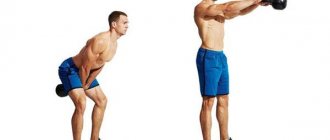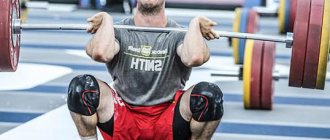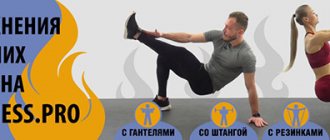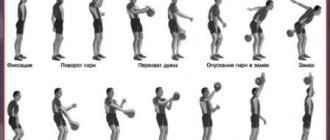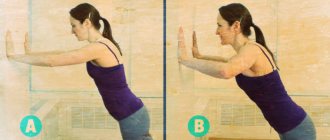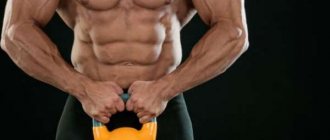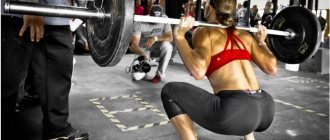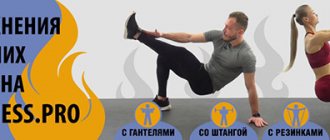| Emblem of the Kettlebell Lifting Federation |
| Weight-lifting |
|
| Theory |
|
| Inventory |
|
| Training |
|
| Competitive exercises |
|
| Preparatory exercises |
|
| Nutrition and recovery |
|
Content
- 1 Dash
- 2 Kettlebell snatch technique 2.1 The trajectory of the kettlebell in the snatch
- 2.2 Exercise training method
- 3.1 Exercise: Kettlebell Snatch
- 4.1 Ten-minute snatch test of USSR special forces
- 5.1 Dress code
What are the benefits of kettlebell lifting?
There are only 3 main exercises in this sport - swings, pushes and jerks. All these movements with apparatus develop the athlete’s dexterity and also affect the health of his joints. Due to the peculiarities of performing such exercises, people involved in this sport feel good about their body. In addition, all movements used in kettlebell lifting are similar to those that a person performs in everyday life. It is for this reason that kettlebell snatches, swings, or cleans will help an athlete better cope with everyday chores around the house.
Dash[edit | edit code]
Kettlebell Snatch
is a classic kettlebell exercise that uses the muscles of the entire body.
- Grip the kettlebell as you would for a one-arm swing. Push the weight out with your hips. When the weight is just above the level of your navel, gently pull it towards you.
- When at some point it seems to you that the kettlebell weighs nothing, push your hand forward. Your hand and handle should be under the body of the kettlebell.
- The weight lies on the forearm. The kettlebell, arm and body are on the same line. Back: Let the weight slide off your forearm, bend your elbow, and stop the weight from moving with your hips and legs.
Kettlebell Snatch
ADVICE:
Time is of the essence. The hand push must be done vigorously and at the right time, otherwise the kettlebell will hit the forearm.
Tips for Performing the One-Arm Kettlebell Snatch
- It is necessary to control the kettlebell during the entire exercise so that it does not hit your hand at the top point; the impact is eliminated by turning the wrist almost at the highest point
- Keep the kettlebell close to your body so it's always under control and you'll spend less effort swinging and releasing it.
- Concentrate on lifting the weight not through your arm muscles, but through your pelvis, so you can do more repetitions.
Let's look at the world records for women's one-arm kettlebell snatch.
Snatch - women (weight 24 kg)
| Weight category | Result | Record holder | Year |
| 58 | 201 | Yaremenko Olga | 2016 |
| 63 | 193 | Dedyukhina Ksenia | 2013 |
| 68 | 200 | Dedyukhina Ksenia | 2014 |
| 68+ | 190 | Anastasia Zolotareva | 2016 |
Kettlebell snatch technique[edit | edit code]
The snatch can be included in the classical combined event program along with the clean and jerk - for men - or can be represented as a separate competitive exercise for women.
The snatch, unlike the clean and jerk, is performed with one kettlebell for 10 minutes with each hand alternately. When performing a snatch, only one change of hands is allowed.
When performing a snatch, the athlete begins the movement from the initial “kettlebell down” position. In the trajectory of movement of the weight in a snatch, we can conditionally distinguish 4 points: the point of swing, the point of detonation of the weight, the point of inserting the hand into the arch of the weight, and the end point - the point of fixation of the hand with the weight.
Let's take a closer look at the entire trajectory of the weight's movement. The swing point is the extreme point from which the forward and upward movement of the weight begins. To perform the exercise most effectively, this point should be located as far back as possible between the athlete’s legs.
This is necessary for maximum inertial force when moving the weight, in order to reduce the load on the arm muscles. So, from the point of the swing, the weight begins an inertial movement forward and upward.
However, the force of inertia is not infinite and the weight sooner or later slows down and stops its inertial movement.
The point at which the inertial force stops moving the weight is the point at which the weight explodes. At this point, the athlete begins to apply his own effort to further lift the projectile. So, what are the actions of the athlete when the trajectory of the weight reaches the detonation point?
When the trajectory of the weight reaches the detonation point, the athlete must make certain efforts to ensure its further movement. At the point of detonation, the athlete makes a sharp reverse movement of the shoulder joint of the arm with the weight back and up, which creates additional force for further movement of the weight.
The next point of movement of the weight is the point where the hand is inserted into the arch. This happens when the projectile is at the level of the athlete's head. Next comes fine-tuning the hand with the weight and directly fixing it.
Kettlebell snatch, front view:
Kettlebell snatch, side view:
Trajectory of movement of the kettlebell in the snatch[edit | edit code]
For a more detailed examination of the technique of performing a snatch, I propose to analyze the entire trajectory of the movement of the weight in the snatch in dynamics. So, the movement of the kettlebell in the exercise begins with a swing
when the athlete moves his hand with the weight to the extreme position between his legs.
A significant nuance here is footwork. For the most rational use of the legs, it is recommended to make a so-called pendulum movement in the swing, when the athlete’s legs, when passing the weights of the lowest point of the trajectory, go into a small squat and then come out of it and straighten at the extreme or starting point of the swing. The quadriceps muscles should relax. When moving the weight from the swing, the work with the legs is of a similar nature with the difference that the exit from the squat occurs at the point where the weight is lifted
. The movement of the weight from the point of swing to the point of detonation occurs inertia, without any effort from the athlete.
Next - lifting the weights
. The detonation occurs at the point when the weight stops its inertial movement. At this point, the athlete makes a sharp movement backwards with a simultaneous reverse movement of the shoulder of the arm with the weight back and up, which gives the movement of the projectile additional impulse.
The next point of the movement trajectory is the point where the hand is inserted into the arch of the weight
.
The hand is inserted into the arch at the point when the hand with the weight is at the level of the athlete’s head. Next - finishing
and
fixing
. After inserting the hand into the arch of the weight, the hand continues its inertial upward movement, stopping at the top point.
To reduce the load on the forearm and hand at the moment of inserting the hand and fixing it, I recommend turning the weight around
so that the bow in further movement is parallel to the body.
In this case, at the milling point, the hand enters the arch from the side, and not from below, which avoids the weight hitting the forearm at the fixation point
. In the fixation position, I recommend holding the hand with the weight so that the position of the hand in the arch and the forearm itself is a straight line, without bending the hand with the weight. This will prevent disruption of the blood supply and will also allow the muscles of the forearm to relax.
The weight is also dropped into the swing by inertia, without applying additional effort to accompany it. The hand should be relaxed. The grip of the bow occurs approximately at the point of detonation of the weight in order to ensure sufficient inertial further movement in the swing.
Here are some general guidelines for performing the kettlebell snatch technique. Next, let's look at the exercise training method. So, since the kettlebell snatch differs from the kettlebell push in terms of the severity of the work performed, the method of training the exercise also differs.
Training method exercises[edit | edit code]
The weight of the kettlebell should vary depending on the level of training of the athlete. Snatch training is typically done after jerk training and can also be done as a separate workout.
Temporary training volume varies from 4 to 20 minutes. Options for training exercises may also vary.
In addition to the classic snatch, it is advisable to include in the training program such exercises as the snatch with one/two additional swings, which will allow, along with the additional load on the forearm, to ensure the correct determination of the point of detonation of the weight, since when performing an additional swing, an important condition is the purely inertial movement of the weight . Also a good exercise would be a snatch while holding the weight statically in a hanging position and in a locked position, which will increase the strength of the forearms, triceps and shoulder girdle muscles. In addition to the main exercises, it is advisable to use so-called auxiliary exercises in the training process. Such exercises include the kettlebell snatch with a glove, when the handle of the kettlebell is completely cleared of magnesium and the glove has a smooth texture. This exercise is performed after the main work and general physical training. Its use in the training process can significantly increase the strength of the forearms. Below is an approximate plan for a monthly training process in the snatch for a trained athlete. The required result is 180–190 lifts of a 32 kg weight for 10 minutes.
1st week
- Monday
32 kg – 4 minutes. Tempo – 20–21 rises per minute. General physical training: snatch 24 kg with two additional swings – 10 minutes. Tempo – 10 lifts per minute.
- Wednesday
32 kg – 6 minutes. Tempo – 20–21 rises per minute. General physical training: snatch 16 kg with gloves – 10 minutes. Tempo – 20 lifts per minute.
- Saturday
26 kg – 150 arm raises without time limit. Tempo – 19–20 lifts per minute.
2nd week
- Monday
32 kg with additional swing - 6 minutes. Tempo: 13 lifts per minute. General physical training: snatch 16 kg with gloves – 10 minutes. Tempo – 20 lifts per minute.
- Wednesday
32 kg – 6 minutes. Tempo – 20–21 rises per minute. General physical training: 24 kg with two additional swings – 10 minutes. Tempo – 10 lifts per minute.
- Saturday
28 kg with additional swing - 150 lifts per minute. Tempo – 13–14 lifts per minute.
3rd week
- Monday
32 kg with additional swing - 6 minutes. Tempo: 13 lifts per minute. General physical training: 24 kg with two additional swings – 10 minutes. Tempo – 10 lifts per minute.
- Wednesday
32 kg – 7 minutes, 3.5 minutes per arm. Tempo – 20–21 rises per minute. General physical training: 22 kg in a glove – 10 minutes. Tempo: 18–19 lifts per minute.
- Saturday
30 kg with additional swing - 140 lifts. Tempo: 12–13 lifts per minute.
4th week
- Monday
32 kg – 4 minutes. Tempo – 21 rises per minute. General physical training: 26 kg with two additional swings – 10 minutes. Tempo – 10 lifts per minute.
- Wednesday
32 kg – 6 minutes. Tempo – 21 rises per minute. General physical training: 22 kg with gloves – 10 minutes. Tempo: 18–19 lifts per minute.
- Saturday
32 kg – separate training, 5 minutes per arm, with a rest of 2–3 minutes. Tempo – 20 lifts per minute.
Exercise space and equipment
The greatest advantage that weights can give is the ability to exercise at any convenient time, as well as in any convenient place. If regular bodybuilding requires a lot of space and a lot of equipment, then for the sport in question you only need weights. In order to perform exercises such as kettlebell snatches, it is recommended that beginners purchase 16 kg equipment.
Over time, the athlete's strength and endurance will increase, and to perform the exercise it will be necessary to change the equipment to heavier ones. First, the weights change from 16 kg to 24 kg, and then from 24 kg to 32 kg.
You can purchase such equipment at a sports store. If you want to save money, you can buy weights from friends or secondhand (for example, through advertisements). In this case, the price will be much lower. There is no difference between the shells, since their appearance and characteristics have remained unchanged for decades.
Options and special preparatory exercises for training the kettlebell snatch[edit | edit code]
Source: “Kettlebell lifting. Training with kettlebells"
.
Management. Author:
instructor Pavel Tsatsoulin, 2015
The fast, powerful one-arm snatch is the king of kettlebell exercises. The Russian military uses snatches instead of push-ups for testing, and they are quickly gaining popularity in the US military. You can find weights in many places where American troops are stationed. US Special Forces conduct a 10-minute test in which snatches are performed with a 24-pound kettlebell. During the test, you can change the “working” hand, and the result of 200 repetitions deserves respect.
The snatch will form an iron back, legs and fingers, develop endurance and have a positive effect on results in running, jumping, fighting and other types of physical activity. Last but not least, the snatch develops willpower and increases the pain threshold.
Exercise: kettlebell snatch[edit | edit code]
Performance:
The kettlebell snatch is performed first with one hand, then with the other.
Rules:
- All control points are the same as for the swing, except for the requirement to keep the arm straight throughout the exercise.
- Take the kettlebell, swing it back between your legs and lift it overhead in one continuous motion, only fully extending your arm in the final phase of the movement.
- Catch the kettlebell gently without hitting your forearm or shaking your elbow or shoulder.
- In the final phase, the hand should be in line with the head or behind it.
- Fix the pose: arms and legs straight, body motionless.
- Lower the kettlebell down between your legs in one free, continuous movement, avoiding your chest and shoulder, then snatch again.
Jerks. Level 1: High Traction[edit | edit code]
An exercise by Anthony Diluglio, a master of Russian kettlebell lifting, can significantly reduce the time spent learning the snatch technique.
Swing the kettlebell back between your legs, just as you would before a swing or clean. Straighten your legs and jerk your elbow back above your shoulder. Use your upper back muscles, not your biceps. Imagine hitting with your elbow rather than lifting it. Synchronize the actions of your legs and back.
At the top of the row, the kettlebell should be an extension of your forearm, neither higher nor lower.
In the final part of the kettlebell row, half the work is done by vigorously extending the arm rather than rotating and lowering the kettlebell. So that you can strengthen the muscles of the upper back and maintain balance. Aim for a moment to make the kettlebell weightless, so that if you want, you can let go of the handle and grab it again without interrupting the exercise.
Lower the weight down between your legs and continue with the exercise.
High rows are a powerful exercise in their own right, not just a lead-in exercise for snatches. The day after doing them, your trapezius muscles may hurt.
Jerks. Level 2: stop[edit | edit code]
The snatch is performed with the strength of the legs, the hand only gives direction to the weight. You can think of the dash as the launch of a three-stage rocket.
The first step is the legs. They work by moving the weight until it reaches chest level.
The second stage is connected by the muscles of the upper back, which pull the shoulder back. The motion is similar to that used when trying to start a boat motor or a chainsaw. Remember high deadlifts? This stage passes faster than the first, it is less powerful.
Third stage - at this stage, the hand with the weight should be weightless. The third stage is fast, all the power is not used here. The hand does not lift the weight, but only puts it into orbit. A quick upward punch with your fist and the weight will fall into place.
Don't forget about throwing the weights. Until you are flexible enough to comfortably throw the weight when stopping, you will not be able to snatch well. Work on your Turkish get up.
Jerks. Level 3: Forearm Safety[edit | edit code]
Try a thought experiment: Imagine swinging a kettlebell upward over your head until the bottom of the kettlebell points up. If you hold the handle with a loose grip, the weight will rotate further by inertia and hit you on the forearm. You don't need it.
Remember the secret to “taming the arc” and reduce the distance between the kettlebell and your forearm as quickly as possible. Think of the snatch as a high pull followed by an instant punch with your “working” hand. When the kettlebell reaches the top, do not allow it to rotate around the handle, moving in a long path and then hitting your forearm. Instead, slam the heel of your palm upward into the handle of the kettlebell, and you'll see the kettlebell land softly on your forearm without hitting it. Perform the blow before you think it is time to do it, perform it at head level. The hand pierces the handle of the weight like a spear, as if putting on a glove. Rotate your arm around the weight, not the other way around. You may notice that the weight does not move directly onto your fist, but rather rolls along your forearm. This is fine. Develop your own style.
Don’t get too carried away with jerking until you have mastered the soft landing of the kettlebell. Practice a little every day, and gain the necessary load with the help of swings and other exercises.
Jerks. Level 4: Don't strain your shoulder and elbow[edit | edit code]
Don't try to pull with your biceps. Draw your shoulder in and lock your elbow moments before you stop, otherwise your shoulder and elbow will flop around with each rep.
Think of the Turkish get-up: “Imagine that the source of energy is in the locked elbow, the energy flows from there into the wrist and into the shoulder. The arm simultaneously lengthens in the direction of the weight and strongly presses the shoulder into the shoulder joint.” This is what needs to be achieved before the final phase of the jerk.
Relax your hand as the shoulder loads. Unclench your fist, you can even move your fingers, allowing the blood to flow down. Don't let your hand bend at the wrist.
Jerks. Level 5: Throw[edit | edit code]
Throwing a weight won't blow your nose. Doing this correctly will allow you to do another repetition, while doing it incorrectly can result in elbow and shoulder injury.
Nothing new. First the pelvis. Bend at the pelvic joint and lower the weight behind you with your arm straight. Lower the weight closer to your body. Doing the exercise against a wall is too risky, but you can imagine the wall in front of you. The movement ends on the heels.
When throwing the kettlebell, you can simultaneously swing your free arm back. In this case, when lifting the weight, the free hand is raised into a boxing guard position. (This technique can be used for one-arm swings.)
Tips[edit | edit code]
Brief tips based on the exercise techniques described above.
- Pelvis First On the way down, hinge at the hip joints.
- on the way up, start the movement from the hips, without allowing the knees to “run” forward.
- To tame the arc on the way down, use the long pass motion.
- on the way up, use the "start the chainsaw" motion.
- snatch and high row: tilt the kettlebell only at the top point.
- Cleans: Imagine lifting the weight to your waist instead of your shoulder.
- Power breathing As you move the weight down, take a sharp breath from your stomach through your nose.
- at the top point, perform a partial exhalation with a sharp “hack”.
- “Breathe behind the shield” - at the moment of vulnerability of the spine, keep your abs ready to strike.
- Free movement Keep your hands free.
- use a hook to hold the kettlebell handle rather than squeezing it.
- Use the laws of mechanics (for jerks only) to retract your shoulder before locking your elbow.
- Lock your elbow completely (extend your elbow all the way).
Joints in kettlebell lifting
Every athlete knows a simple truth - you cannot use a muscle without using a joint. So, in kettlebell lifting, like in any other, a large number of joints are involved. However, there is a slight difference. When performing any exercises, the joints work in turn, since the technique is divided into several parts. There is no such thing in the kettlebell snatch. This means that all the joints that are involved in the work do so almost synchronously.
On the one hand, this is good, since in this case the load is distributed over several areas, each of which in some way insures the other. However, this is the problem. If the movement technique is violated, there is a high risk of causing serious injury to oneself, which will affect many joints at once. It is for this reason that experienced coaches and athletes say that in kettlebell lifting technique is above all else. You cannot work “to failure”, as in bodybuilding. You need to do a little at a time, studying the technique of performing the selected exercise with the apparatus.
Snatch training[edit | edit code]
Main article:
Kettlebell training program
Strength and endurance are achieved in different ways. To build endurance you need jerks
and swings.
High-rep kettlebell rows are done on the same days as bench presses, after bench presses. Your training should not be measured in repetitions, but in minutes, like the USSR snatch test. Open Dan John's book, roll a couple of dice and try your luck. If you get two ones, do snatches for two minutes; if you get a pair of sixes, consider yourself lucky and do snatches for 12 minutes.
Follow a heavy-light-moderate training pattern. Saturday is a hard day. Add swings. Find out how many repetitions you can do in the time given by the dice. You can do as many or few repetitions as you wish, lower the weights to the floor if necessary, the main thing is that it is difficult for you. This is how you become the best.
Monday is an easy day. This is the day of the jerks. Roll the dice again and do 50-60% of the number of reps you can do if you go all the way.
Wednesday is an average day. Swing again. 70-80% of the maximum. You don't have to be extremely precise. Approximately - this is normal. The key concept in this training should be “moderation.” As one of my students said, until a “comfortable stop.”
For example, let's say on Saturday you went all the way in your swings and did 100 reps in 5 minutes. On Monday the dice roll is 10 and you snatch but only press halfway for 75 reps. Wednesday is an average day for swings. You again have 5 minutes and perform 70 swings. Keep accurate records. This is what a workout should look like.
- Swings 24 kg x 100 in 5 minutes are a tough workout.
- Snatches 24 kg x 75 in 10 minutes - an easy workout.
- Swings 24 kg x 70 in 5 minutes - average workout.
Ten-minute jerk test of USSR special forces[edit | edit code]
The kettlebell jerk is performed as many times as possible within 10 minutes. All fighters use a 24kg kettlebell and also need a uniform, appropriate shoes and a stopwatch.
Required sports quality: strength endurance.
Fifth complex
There are complexes in CrossFit that are not designed for rigid time recording. Your task is to act quickly and deal with approaches as early as possible. You will improve not only your balance, but also your endurance and coordination. Procedure:
- Steps onto a 50 cm pedestal (16 repetitions).
- Double jumps (50 pieces).
- GHD (lifting the body on a simulator, 18 times).
- Twenty simple push-ups.
Important! Monitor your pulse. The difficulty is that this complex is performed at speed. The faster you complete the task, the better.
Summarize . CrossFit has a lot of exercises and complexes using dumbbells. By skillfully alternating these exercises in your training program, you will be able to achieve impressive results. Consult with your trainer to find the optimal combination of load and execution time.
Dash rules[edit | edit code]
Dress code[edit | edit code]
Participants must wear T-shirts tucked into long pants and wear combat boots or other durable boots. Clothes must be clean and ironed, shoes must be clean. The dress code will be strictly enforced.
If a trouser belt is used, it should sit on the hips and not support the spine like a corset. A weightlifting belt should not be used, but gloves, wristbands, or other devices may be used.
Use magnesium[edit | edit code]
An athlete can use magnesium to strengthen his grip. The projectile is cleared of magnesium after each test or if another participant requests it.
One-handed snatch[edit | edit code]
The competitor picks up the implement, swings it back between the legs, and pulls it out over the head in one continuous motion all the way to the top point at which the elbow is locked (that is, the arm at the elbow is extended as far as possible). After fixing the weight in the top position, the participant lowers it down in one smooth movement. The arm may be bent at the elbow, but the kettlebell does not rest at the shoulder or chest.
Your free hand can be on your hips and you can move your legs. When fixing the weight in the upper position, you need to stop all movements. Arm and legs are straight.
The judge counts each repetition or says “not counted.” A repetition is not counted if the competitor does not fully straighten the working arm or legs, does not bring the kettlebell to the top position, or touches the platform with a knee or hand.
You are allowed to change hands at your discretion. Several swings of the kettlebell between the legs are allowed when changing hands or before the jerk.
You are allowed to place the weight on the platform as many times as you like.
2 minutes before the attempt, the participant is called to the platform. A 10-second countdown is given: 10, 9, 8, 7, 6, 5, 4, 3, 2, 1, then the “start” command is given.
The participant is given 10 minutes to complete the test. The judge announces every minute. After 9 minutes, “30 seconds”, “50 seconds”, “55 seconds” are announced.
It is forbidden to talk during the test.
When a participant finishes an attempt or violates the rules, which requires the test to be stopped, the command “stop” is given and the number of repetitions performed correctly is reported.
Special rules and penalties[edit | edit code]
If a competitor uses profanity or behaves in an unsportsmanlike manner during the test, he may be subject to a penalty of five reps deducted; if the competitor violates the test again, he may be disqualified at the discretion of the judge.
The influence of kettlebell lifting on humans
The main impact of an exercise such as the 16kg kettlebell snatch is primarily on forearm strength and grip strength. These indicators are very important, since a strong grip is the key to success in some other exercises. For example, when doing pull-ups, it is very important to have developed forearms, since a lack of strength will not allow you to fully develop the capabilities of other muscle groups. This means that the number of repetitions in other exercises and their effectiveness will drop noticeably.
Kettlebell snatch and jerk: how to breathe correctly?
Many novice athletes do not think about the need to breathe properly. Training with weights quickly causes oxygen starvation in the body. Errors in breathing lead to insufficient oxygen supply to the body, as a result, the muscles will quickly tire. Kettlebell lifting involves exhaling when applying force and exhaling at the stage of muscle relaxation.
When performing exercises with weights, it is recommended to adhere to breathing, consisting of 3 cycles:
- inhale when lifting the projectile and exhale when detonating;
- inhale when performing a squat and exhale when straightening the body and arms;
- inhale when the weight reaches chest level when lowering, exhale until the swing.
If it is not possible to maintain the breathing rhythm, it is recommended to do several breathing cycles, performed while fixing the projectile in the upper position. The speed of the exercise will slow down, but will allow you to get a sufficient amount of oxygen.
What muscle groups work?
Despite the fact that the kettlebell push develops all major muscle groups, the main profile is the development of the triceps and medial deltoids, which bear the greatest load.
| Muscle group | Movement phase | Load type |
| Upper chest bundle | Primary push impulse | Pulse dynamic |
| Triceps. Lateral head | Kettlebell extension | Basic dynamic |
| Deltas - upper beam | From lifting the weight to the final static tension in the fixation | Basic dynamic |
| Deltas - anterior beam | First phase of pushing movement | Pulse dynamic |
| Biceps hamstrings | Keeping your legs straight while changing your body | Static constant |
| Quadriceps | Setting an impulse to the body | Pulse |
| Biceps flexor arm | Stabilization during the stage of lowering the weight to the shoulder | Static stabilizing |
| Wrist muscles | Hold the kettlebell throughout all stages | Static |
| Trapezius muscles | Holding the weight on your shoulder at the correct angle | Dynamic secondary |
| Rhomboid muscles | Transmission of primary impulse from quadriceps + core stabilization | Pulse + static |
| Psoas muscles | Core stabilization throughout the exercise | Static stabilizing |
| Gluteal muscles | Creating additional momentum when pushing with two hands | Pulse dynamic |
As can be seen from the table, despite the involvement of large muscle groups, the main dynamic load is taken by the muscles of the shoulder and forearm. Thanks to this, kettlebell complexes perfectly work out the small muscles of the arms, which are lagging behind in people who practice exclusively basic movements.
